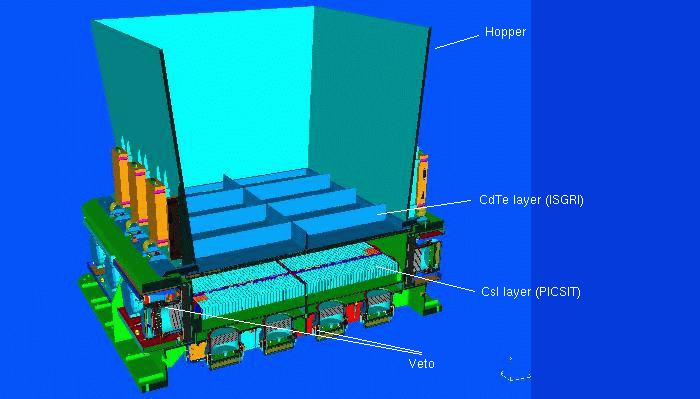Instruments IBIS - INTEGRAL
IBIS: Imager on Board the INTEGRAL Satellite
 Principal Investigator: Pietro Ubertini, INAF/IASF-Rome Italy
Principal Investigator: Pietro Ubertini, INAF/IASF-Rome Italy
Co-Principal Investigators:
Philippe Laurent, CEA-Saclay, France
Guido DiCocco, INAF/IASF-Bologna, Italy
with collaborating scientific institutes in Italy (INAF/IASF-Rome, INAF/IASF-Bologna, INAF/IASF-Palermo), France (CEA Saclay), Norway (U Bergen), Germany (U Tübingen), Spain (U Valencia), USA (NASA/MSFC Huntsville), Poland (Space Research Centre, Warsaw), UK (U Southampton).
IBIS, the Imager on Board the INTEGRAL Satellite, is a coded-aperture instrument that provides fine imaging (12' FWHM), source identification and spectral sensitivity to both continuum and broad lines between 15 keV and 10 MeV. The total field of view (down to zero response) is 29.1° x 29.4°, and the fully coded field of view is 8.3° x 8°. The tungsten coded-aperture mask, optimised for high angular resolution, is located at 3.2 m above the detection plane. As diffraction is negligible at gamma-ray wavelengths, the angular resolution of a coded mask telescope is defined by the size of the mask element as seen from the detector plane, (assuming that the size of a detector pixel is smaller or equal to that of the mask element).
IBIS is composed of two detector planes: ISGRI and PICsIT separated by 90 mm. ISGRI, the top layer, has a collecting area of 2600 cm2, is sensitive between 15 and 1000 keV with maximum effective area between 20 and 100 keV. It consists of 8 modules of 64x32 CdTe pixels (128x128) for a total of 16384 pixels, each measuring 4x4 mm (2 mm thick), and spaced by 0.6 mm. Each module has 64x32 pixels and the space between modules is of 2 pixels. There are 2 modules horizontally, and 4 vertically. Therefore, the detector image or shadowgramme has a size of 130x134 pixels (2*64 + 2 = 130 and 4*32 + 3*2 = 134). PICsIT, the bottom layer, has a collecting area of 3000 cm2, is sensitive between 100 keV and 10 MeV, with maximum effective area between 200 and 400 keV for single events, and a rather uniform sensitivity for multiple events between 500 keV and 10 MeV. It consist of the same 8 modules configuration as ISGRI, but with 32x16 CsI pixels (64x64) for a total of 4096 pixels, each measuring 9x9 mm (30 mm thick). Having two separate detectors permits the reconstruction of the angle of incidence of photons when they interact in both layers. This allows for what is referred to as the Compton mode of operation.
For more details we refer the interested reader to ISOC's Announcement of Opportunity documentation of the IBIS Observer's Manual and to a sequence of papers on the IBIS payload in the A&A Special Letters issue on: First science with INTEGRAL. This issue also contains various other papers on the first results from in-flight observations. For descriptions of the IBIS data analysis we refer to, e.g., Goldwurm et al. (2003, A&A 411, L223) and Gros et al. (2003, A&A 141, L179). The validation reports of the ISDC Off-line Scientific Analysis (OSA) software package released by the ISDC for ISGRI and PICsIT, as well as descriptions of the data analysis pipelines and modules and the use of the OSA software can be found at the ISDC website (https://isdc.unige.ch/integral/analysis#Documentation).
Imager IBIS page at INAF/IASF-Rome, Italy
Overview of scientific capabilities of IBIS
| Energy range | 15 keV - 10 MeV |
| Detector area | 2600 cm2 (CdTe - Cadmium Telluride) 3000 cm2 (CsI - Caesium Iodide) |
| Spectral energy resolution (FWHM) | 8% @ 100 keV 10% @ 1 MeV |
| Field of view |
8.3° x 8.0° (fully coded) |
| Angular resolution | 12' FWHM |
| Point source location accuracy (90% error radius) | 30" @ 100 keV (50σ source) 3' @ 100 keV (5σ source) 5-10' @ 1 MeV (5σ source) |
| Continuum sensitivity* |
2.85e-6 ph/(s cm2 keV) [3σ in 10e5 s, @ 100 keV, ΔE = E/2] |
|
Line sensitivity* |
1.9e-5 ph/(s cm2 [3σ in 10e6 s, @ 100 keV] |
| Timing accuracy |
61 μs - 1 hr |
| Typical source location | 30" @ 100 keV (50 sigma source) 3' @ 100 keV (5 sigma source) |
| Resources (following EID-A allocation): | |
| Mass | 677 kg (+ 96 kg for tube inside PLM) |
| Power (sun/eclipse) | 240/0 W |
| Data rate (solar maximum) | 59.8 kbps |
| Date rate (solar minimum) | 56.8 kbp |
* The sensitivities are based on in-flight background measurements.
Back to the INTEGRAL Scientific Payload page
- Removed a total of (3) style text-align:center;
- Removed a total of (1) style float:right;
- Removed a total of (1) align=center.
- Removed a total of (1) border attribute.








































 Sign in
Sign in
 Science & Technology
Science & Technology